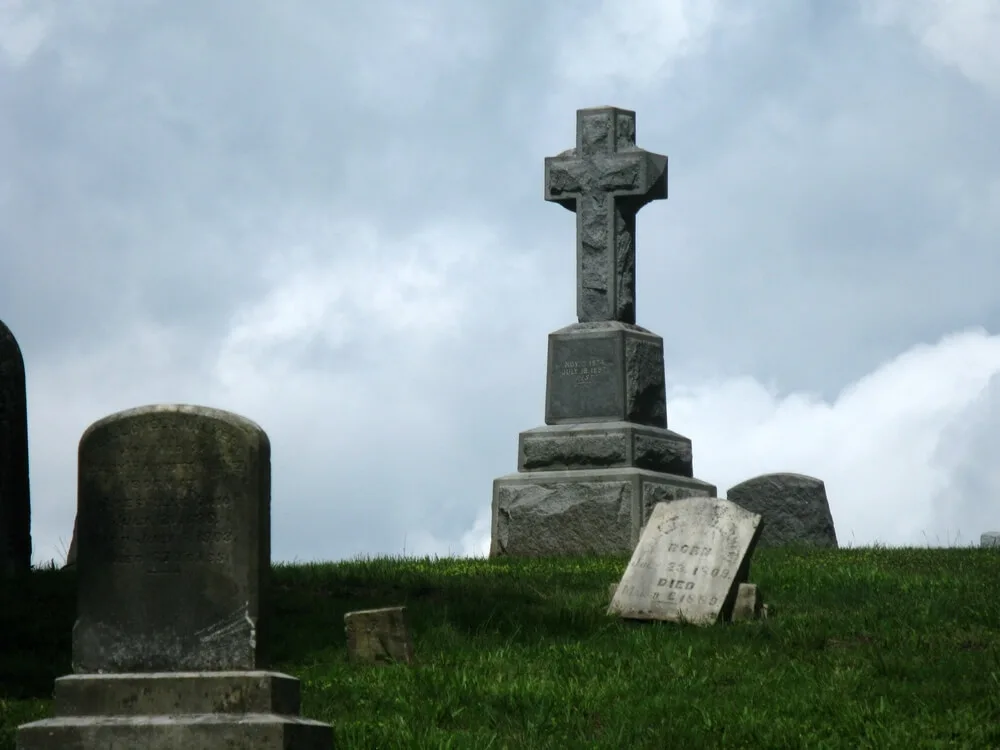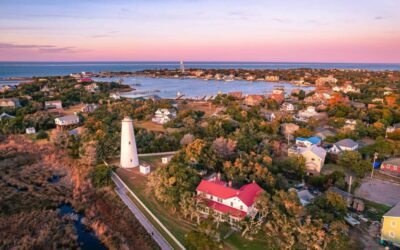
Here lies North Carolina's literary giants. Riverside Cemetery in Asheville is the final resting place for Thomas Wolfe and O. Henry, as well as plenty of other historic western NC graves. (Shutterstock)
We’ve been scoping out North Carolina’s oldest, most haunted, and most hidden cemeteries.
Unless you are someone with a deep appreciation for schadenfreude, visiting a graveyard for pleasure probably doesn’t top your daytrip bucket list. But then again, maybe it should.
Whether you’re interested in exploring North Carolina’s rich historical heritage, discovering sculpture that rivals museum collections (for free!), or just want to have your first ghost sighting, you may already have one foot in the grave.
Oh come on, I didn’t mean it that way.
Here at Cardinal and Pine, we’ve been sleuthing out North Carolina’s oldest, hauntedest, and hiddenest burial grounds just for you. And other than bringing water and bug spray, our best advice for a trip to these elusive boneyards is to expect the unexpected.
Oldest Graveyards
- Town Creek Indian Mound, Mt. Gilead, NC
Given the tacit axiom that all medieval characters speak with an English accent, you might be surprised to find a medieval burial ground about halfway between Charlotte and Fayetteville.
The Town Creek Indian Mound is the site of a civil and ceremonial center built by the Pee Dee or South Appalachian Mississippian culture around the 11th century C.E.
Among the ruins of the mortuary hut, archaeologists discovered burial urns for small children. The clay urn was set into the ground with its rim slightly visible, then the bottom was broken free with a rock to help the child’s spirit pass through the vessel into another world.

- Old Burying Ground, Beaufort, NC
The oldest clearly marked gravestone in North Carolina belongs to Daniel Little, decd. 1775 and can be found in the Old English Cemetery in Salisbury. However, many of the moss-flecked tombstones at the Old Burying Ground in Historic Beaufort, are believed to be older, from the 1730s or earlier. Unfortunately, the stones have become so weathered over the years that their epitaphs deteriorated into a smooth silence.
Bring a shell or small children’s toy to leave at the wooden tombstone of the Rum Keg Girl. According to the legend, against her mother’s wishes, a young girl joined her father on a trading voyage to London. The girl died on the journey, but the father refused to bury her at sea even though they were weeks away from land. He’d promised his wife that he’d bring her back to Beaufort. So he bought a cask of rum from the crew and sealed his daughter inside.
Most Haunted Graveyard
- Cabelands Cemetery, Durham, NC
While the main trails of Eno River State Park are familiar stomping grounds to many in the Triangle, a little bit of bushwhacking on overgrown paths leads to the (literally) hauntingly beautiful remains of the Cabelands–an abandoned 1700s homesteading community along the Eno River.
The Cabelands Cemetery has 50 graves but only 12 remaining markers. Depressions in the ground hint at the rotting caskets below, and many are outlined with rings of small stones. Ghost sightings and eerie whispers have been reported by hikers on the river bluff nearby.
Fortunately, all otherworldly encounters have thus far remained cordial.
Most Bookish Graveyards
- Riverside Cemetery, Asheville NC
The Riverside Cemetery in Asheville is the final resting place of many of North Carolina’s literary legends including Thomas Wolfe and William Sydney Porter (O. Henry). Visit this site on the banks of the French Broad early in the morning to watch a golden fog ascend from the roiling current. It’s sure to inspire a poem, if not an entire novel.
And with the rollercoaster ride of our current economy, we may all soon be pulling a Gift of the Magi and selling our Fitbits for hair clips.

- Old Scotch Graveyard, Carthage NC
We may have to agree to disagree with the Outlander showrunners about the geography of North Carolina (no, Wilmington is not a day’s carriage ride from the Blue Mountains!).
But one thing they and Diane Gabaldon did get right was the volume of Scottish immigrants living in North Carolina before the Revolutionary War.
The Old Scotch Graveyard is the final resting place of many of Jamie Fraser’s real-life counterparts. Just off of Route 1261, discover gravestones with gaelic epitaphs and curling script among the oaks and pine.
Most Hidden Graveyards
- Geer Cemetery, Durham NC
Across North Carolina, it’s often neighbors who are leading the charge to recognize the Black heritage of their communities. In Durham, a group of locals uncovered a long hidden Black graveyard from the undergrowth. Among the 2,000 interred are people who were once enslaved at nearby plantations before the Civil War, as well as doctors, teachers, and other prominent community members from the Reconstruction Era.
Now the Friends of Geer Cemetery offer guided and self-guided tours to respectful visitors. There are also signs and archival photos which pay tribute to the vibrant history of this community. Similar restoration efforts are also underway at a newly recovered Black graveyard in Ayden, North Carolina, about 90 miles southeast of Raleigh.
- Bnai Israel Congregation Cemetery, Wilmington NC
Tucked into a quiet corner of the historical Carolina Place in Wilmington, this Jewish cemetery–a passion project of the first Jews of Wilmington–has been in continuous use since 1898.
The son of the original cemetery manager is still involved in its leadership today. But few Wilmingtonians know of its existence.
To use a famous Hebrew aphorism (which has been in continuous use over 1000 years), ha-mevin yavin, it’s on a “need to know basis.”
The oldest graves are found in the shade of live oaks along the southern side of the property, including the casualties of the 1918 flu pandemic. Visitors may also notice an ornate fountain at the entrance of the cemetery. Jews traditionally wash their hands when leaving a cemetery to make a ritual distinction between the world of the dead and the living.

Which NC cities are best to retire in? Here’s how they rank
A new WalletHub listing takes a look at the top 182 US cities to retire in. NC cities didn't fare too well. A recent study from WalletHub...

Meet the NC turkeys pardoned this Thanksgiving
Every Thanksgiving since 1989, leaders in America have offered a reprieve to a few lucky gobblers. Here are the NC turkeys pardoned this year. Two...

North Carolina’s top choose-and-cut Christmas tree farms
Come for the Christmas tree farms and stay for the cozy cabins in the Smoky Mountains. Imagine taking in the views of beautiful forest green-colored...

North Carolina’s top choose-and-cut Christmas tree farms
Come for the Christmas tree farms and stay for the cozy cabins in the Smoky Mountains. Imagine taking in the views of beautiful forest green-colored...

Hungover in Raleigh? Try these 10 cures, from food to IV treatments
With Raleigh’s top hangover remedies, a fun night out doesn’t have to ruin your day. Discover the best hangover cures in town. With so many fun...




